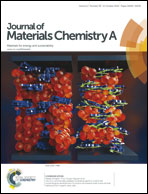Bio-derived calcite as a sustainable source for graphene as high-performance electrode material for energy storage†
Abstract
Graphene is a promising material for energy conversion and storage applications. However, the production of graphene is limited by their complicated and high-cost processing. Here we have shown that graphene could be synthesized by a simple magnesiothermic reduction reaction from eggshell, a sustainable precursor of bio-calcite produced at a rate of tens of millions of tons annually. Due to their intrinsic structure (e.g., porous structure, high crystallinity), the synthesized graphene could be used as a promising electrode material with high-capacity, high-rate capability and long cyclability. At a specific current of 100 mA g−1, they exhibited a reversible capacity of 678.4 mA h g−1. Even at an extremely high discharge/charge current of 20 A g−1 (about 27 s to full charge), it retained a capacity of 149.9 mA h g−1 after 1000 charge/discharge cycles. At such rate, it could exhibit a specific energy density of 253.9 W h kg−1 and a specific power density of 32.6 kW kg−1. The results suggested that bio-calcite derived from eggshell could be a sustainable and ample resource to synthesize graphene for energy storage.


 Please wait while we load your content...
Please wait while we load your content...